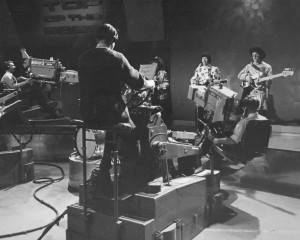The Vinten Heron was a camera crane built to a BBC spec in the early sixties. It was in regular use till the early eighties, and probably did a large part of its work on Top of the Pops. The first mark 1 version was very tricky to operate, especially for the tracker, as the hydraulic throttle went from stop to full speed in a tiny fraction of the lever quadrant.
Another difficulty for the tracker was that the machine would work either in steer or crab. In steer mode the steering wheel operated the back pair of wheels similar to other cranes such as the Mole Richardson. In crab mode it operated all of them together but worked backwards so that turning it to the right sent the Heron off to the left. Oh Joy!
My personal (Bernie) introduction to the Heron was Top of the Pops in Studio G at Lime Grove 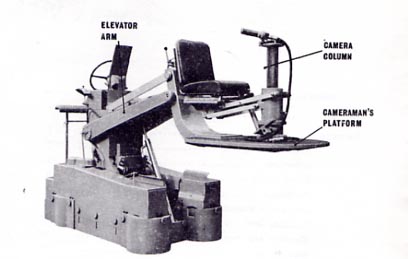 in 1967. The later Mk 3 version was already in service, with footpedals all round, but for some ancient Tech Ops reason, the two kept at Lime Grove for the most difficult show of each week were Mk1s.
in 1967. The later Mk 3 version was already in service, with footpedals all round, but for some ancient Tech Ops reason, the two kept at Lime Grove for the most difficult show of each week were Mk1s.
The cameraman had two panning handles on the left, one with a zoom control, and the other with a progressive hydraulic crane control. Most of the time on TOTP he needed to work both at once, and the focus with the other hand – and change his shot cards with his….?
It was the mark of a man if you could drive a Heron in a figure 8. Long after I left tech ops I tried it again one day, and it was like riding a bike – my hands and feet still knew what to do, though the rest of me had long forgotten.
From Peter Ward
Here’s my experience of when the Heron was first used on a drama. I was on Crew Ten and usually opted to man a camera on drama but on the Heron’s first outing on a play , I volunteered to track Tony Abbey on camera 1. The Heron in its experimental stage had a fearsome turn of speed which was later tamed and although it made its drama debut on the two day rehearsal described below, it never made it to transmission.
The following is an extract from DAYS OF VISION by Don Taylor (1990 Methuen Drama). Don Taylor was an excellent director who nearly always worked with Crew Ten on the David Mercer plays such as “Morgan, A suitable Case for Treatment” and many others. Norman Crisp’s “The Alderman” was transmitted live on Sunday evening at 9pm on the 28th January 1962 from TC3, about eighteen months after TV Centre opened. This is what Don Taylor writes about that event.
“Fittingly for my last but one live play, it memorably dramatised the dramas and thrills of live television. After two days’ camera rehearsal, and about five minutes before transmission, camera one broke down, or, to be precise, its mounting ceased to function. The dolly was a new one, called the Heron, still in the experimental stage, which had the ability to turn its wheels into a new plane, so as to make crabbing movements without curving, and with the camera mounted on an arm which enabled it to elevate to a height of about nine feet. It was quite clear that this machine was kaput, and was not going to be made to work in five minutes. In these circumstances the BBC guidelines for a director were quite clear. He was to go on the air on time, improvising so as to cover the shots from the unavailable camera. This is a regulation which may well work with discussion shows, and the simpler light entertainment programmes, but with the sophistication which live drama had reached in the early sixties, which was in effect a kind of instant film making, with a wide range of shots and fast and imaginative cutting having become the normal visual language of most of the decent directors, it simply wasn’t possible to go on the air with the principal camera missing: so we rang up Presentation and told them that we weren’t ready, and they would have to wait.
It was nine o’clock, the very height of peak time, and we were presenting the nation with what Sydney Newman would have called ‘dead air’, the ultimate crime! My technical operations manager had already started raiding the studio next door, which was not working that night, for a pedestal mounting, but it had to be brought into the studio, mounted, and warmed up, which would take a few minutes. But I was quite determined, in spite of the screams coming down the phone from Presentation. So the nation watched the potter’s wheel and the stream, and listened to bland music for five minutes, till we eventually went on the air at five past nine.
Our problems were by no means over. The Heron was a motorized camera, driven by a tracker, which elevated and depressed mechanically, while the cameraman sat on a little seat behind the viewfinder. With this machine we had rehearsed for two days. Now, Tony Abbey, the number one cameraman, had a pedestal, the standard TV camera, worked by one standing cameraman, pushed about, elevated or depressed, by brute force, and only capable of going to about six feet in height. I had made good use of the Heron’s mobility, having it move about the studio over large distances, both back, forward and laterally,at 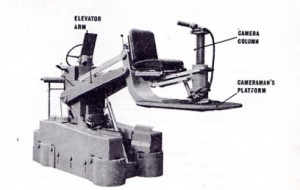 some speed. There was no alternative but for Tony Abbey and his tracker Peter Ward to push the pedestal, going as fast and getting as high as possible, through the script I had plotted for the Heron. My function was to talk non-stop down the microphone, warning Tony of what was coming next, so that he would be ready to make each difficult move a good few seconds before it came, and not be caught out: one of the reasons why a television director must know his script, both words and pictures, by heart. Tony Abbey was a master artist among cameramen, as were all the members of crew ten, the one I always worked with in those days, and he did an immaculate craftsman’s job. No one would ever have assumed anything was amiss, and only I knew that some shots planned to be taken from nine feet in the air were actually taken from six. Tony adjusted the compositions as he found them, and his eye made beautiful pictures, as television cameramen invariably do. It was thrilling, and everybody felt the buzz. The play went extremely well, and probably had an extra edge that it would have lacked without the crisis that preceded its transmission, and the sense of occasion of Tony Abbey’s triumph. The story makes a kind of wry epigraph on live television drama, so thrilling and exciting a medium to work in, simply because it is fraught with the possibility of disaster, as every performance in the theatre is, every night.
some speed. There was no alternative but for Tony Abbey and his tracker Peter Ward to push the pedestal, going as fast and getting as high as possible, through the script I had plotted for the Heron. My function was to talk non-stop down the microphone, warning Tony of what was coming next, so that he would be ready to make each difficult move a good few seconds before it came, and not be caught out: one of the reasons why a television director must know his script, both words and pictures, by heart. Tony Abbey was a master artist among cameramen, as were all the members of crew ten, the one I always worked with in those days, and he did an immaculate craftsman’s job. No one would ever have assumed anything was amiss, and only I knew that some shots planned to be taken from nine feet in the air were actually taken from six. Tony adjusted the compositions as he found them, and his eye made beautiful pictures, as television cameramen invariably do. It was thrilling, and everybody felt the buzz. The play went extremely well, and probably had an extra edge that it would have lacked without the crisis that preceded its transmission, and the sense of occasion of Tony Abbey’s triumph. The story makes a kind of wry epigraph on live television drama, so thrilling and exciting a medium to work in, simply because it is fraught with the possibility of disaster, as every performance in the theatre is, every night.
……………………………………..
And more on the Heron….
From Trevor Webster
Well know Sound Supervisor Trevor Webster doesn’t a have skeleton in his cupboard (well, he might have, I suppose), but he did find an operators handbook for a Mark 1 Vinten Heron Camera Crane, with Camera Dept stamped inside the front cover. Trevor has no idea how he had it, and he doesn’t have too many times when he needs it these days, so he sent it to me, where it joins other material in my memorabilia folder.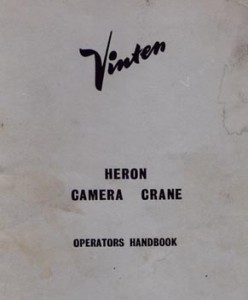
Here’s the cover. I’m not sure when they were introduced, and the book has no date, but I guess around 1964.
Here’s page 1, in your basic typewriter (a mechanical writing machine of the last century) – unreadable of course, unless you look at the large version by clicking on it. Somewhere, stashed away here, is the whole book.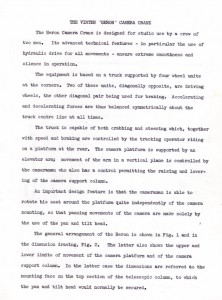 ……………………………………………
……………………………………………


